




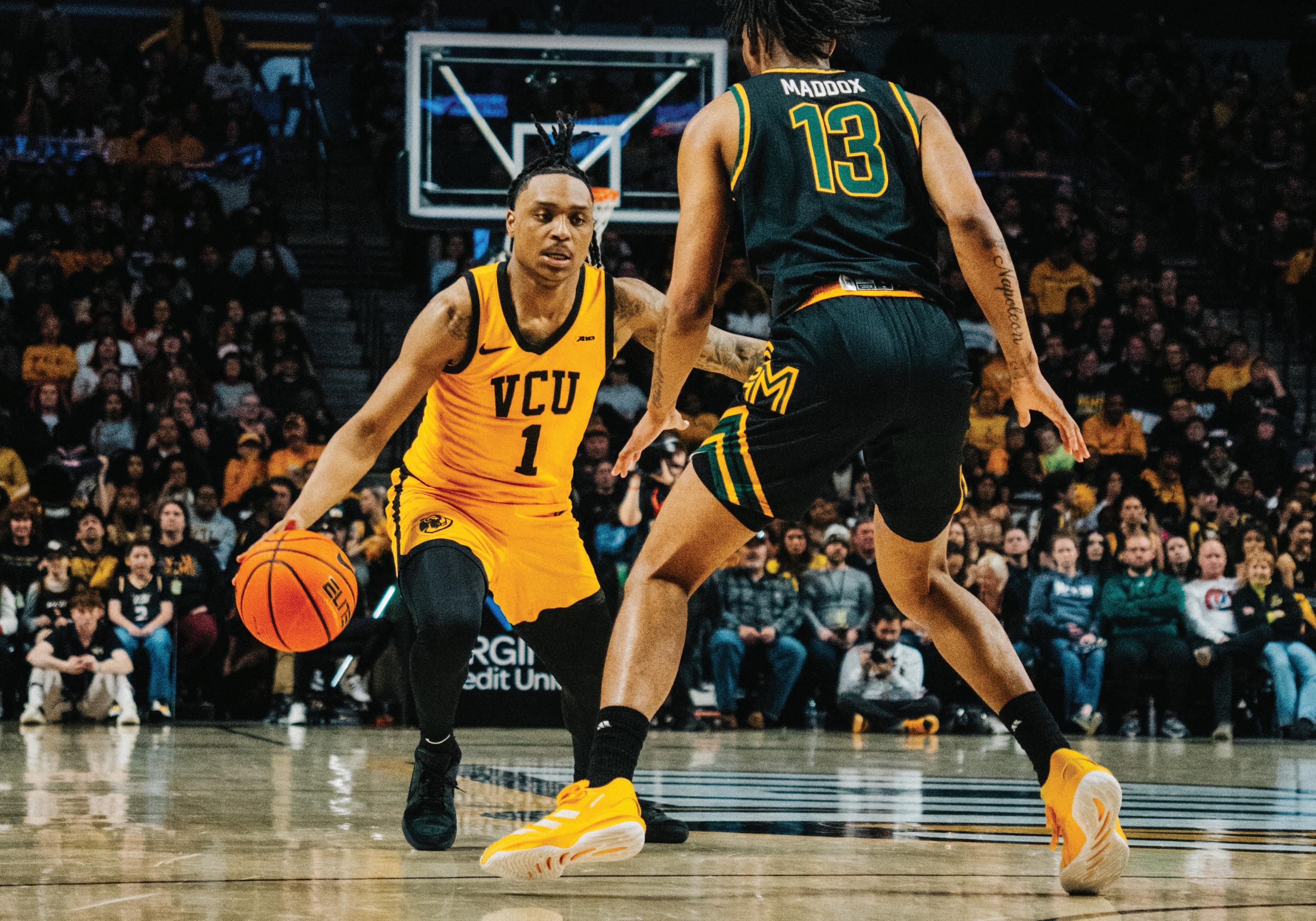

MOLLY MANNING
Contributing Writer
Hundreds of protestors amassed at Capitol Square at 2 p.m. on Presidents’ Day, Feb. 17. Bearing American flags, Virginia flags, assorted rainbow flags and signs with statements like “Stop the coup” and “You can’t spell felon without Elon,” the crowd echoed chants such as “The people united will never be defeated.”
Many participants claimed that the protest was part of a movement for
“No King’s Day,” according to NBC12. This protest was a second iteration of the “#50501” protests, an idea born out of a Reddit movement for 50 protests in 50 states in 1 day against the “antidemocratic and illegal actions of the Trump administration and its plutocratic allies,” according to #50501.
See PROTEST on page 2

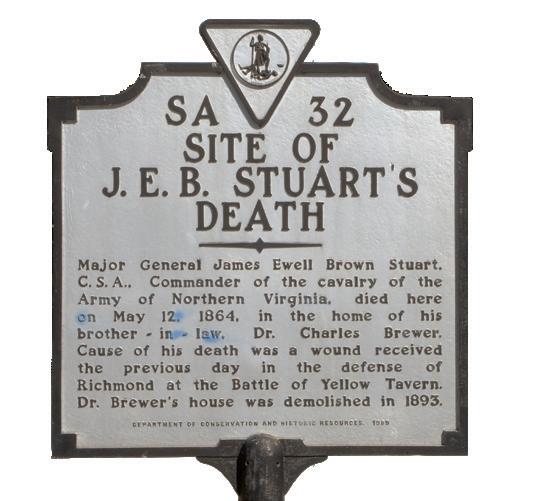

KYLER GILLIAM Staff Writer
BRIANNA COBBS
Contributing Writer
A sold-out Siegel Center, an electric crowd and a brewing inter-state rivalry set the stage for the high-stakes Homecoming match-up between the VCU Rams and George Mason Patriots.
“The atmosphere was tremendous. Wonderful. We loved it. I want to thank this whole school. We needed that,” said VCU graduate student guard Phillip Russell.
See VCU vs. GMU on page 6

Signs of the times Richmond’s highway markers recognize a rich history
See HIGHWAY SIGNS on page 2
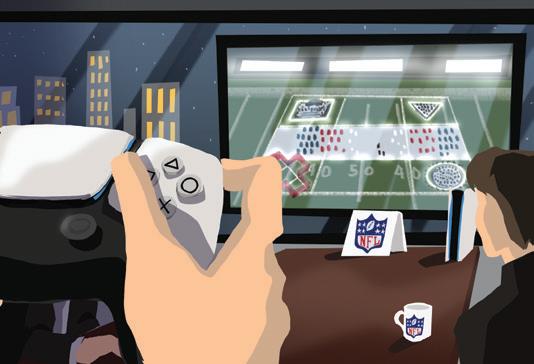
Lisa Sinervo, a member of the Richmond community, attended the protest dressed as a king, citing the separation of powers as the reason for her attire.
“It has completely deteriorated under Trump, and because he’s someone who’s not really interested in public welfare, it’s a really serious problem that someone doesn’t respect the separation of state,” Sinervo said.
The #50501 press release describes the movement as a coalition for justice, transparency and ending executive overreach. The release also includes that the initial mission of the organization is to stand against the harmful impacts of the current presidential administration and Project 2025.
Park ranger Maggie Markley said they drove from Newport News for the protest.
“I came out because Elon Musk — that’s the real hard hitter. It sucks that as a people we all are very divided, but it’s nice to know that Elon Musk is pissing everybody off just enough where you can get enough people to show up,” Markley said.
Other signs at the protest included phrases such as “The emperor has no clothes,” “Make integrity presidential again” and “No dictators, no kings.” Many community members of all ages were present, including families with children. Both Capitol and State Police were present on the outskirts and throughout the crowd monitoring the event.
Adrienne Voorhis, a Richmond community member, shared that she was at the protest out of fear for the state of the country.
“I’m out here because I’m terrified that we are headed the wrong direction,” Voorhis said. “I would like to maintain our democracy, and I think that the wrong elected people are in government now, but we should be able to elect the people who are representing us and President Musk is not elected.”
national: The New York Yankees relaxed their long-standing facial hair policy, allowing “well-groomed beards” for the first time since the 1970s when the policy was introduced.
international: Asteroid 2024 YR4’s probability of striking Earth in 2032 dropped to nearly zero after new observations, NASA announced.
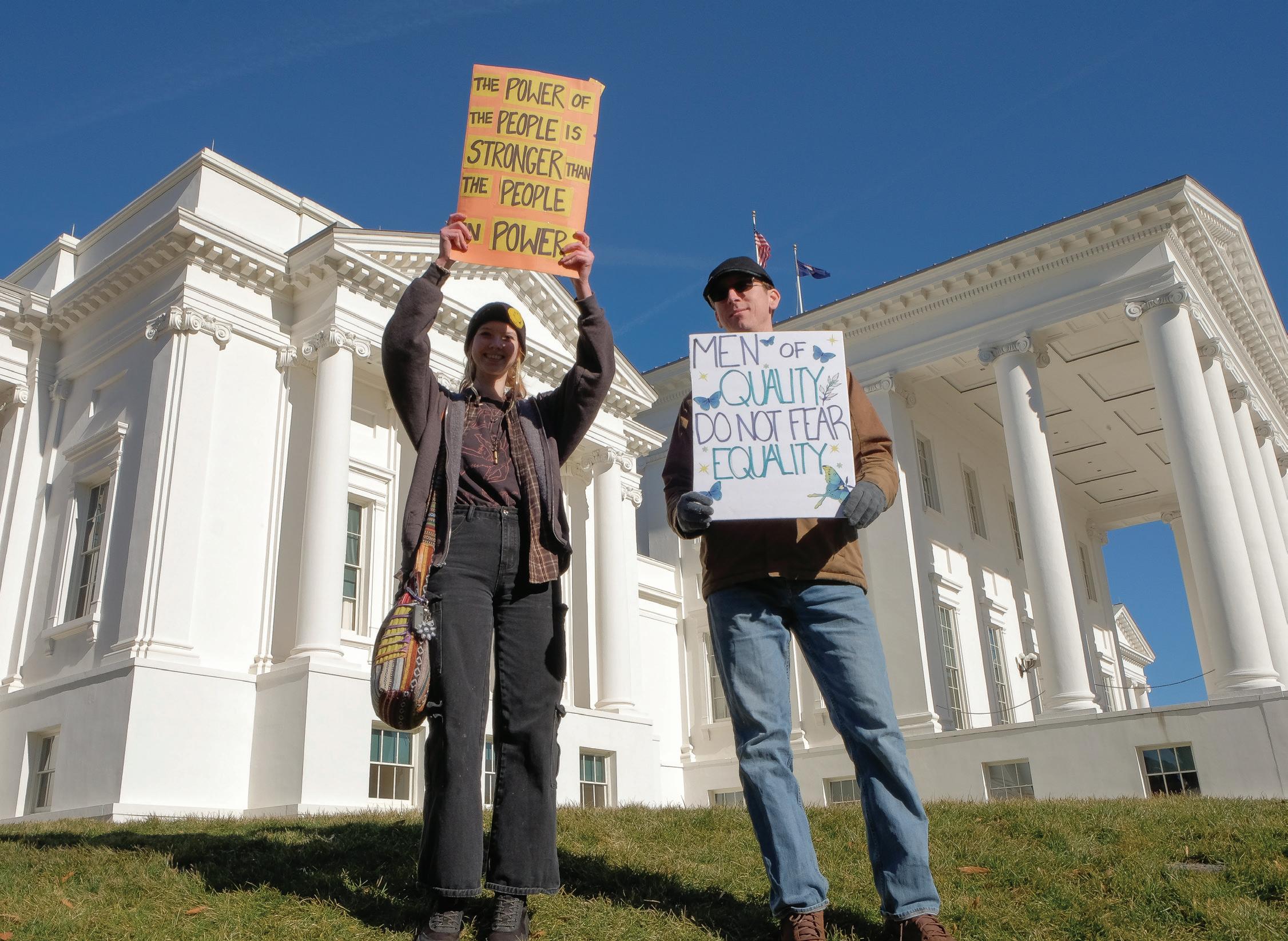
Supporters and volunteers for various Democratic candidates, including Senator Ghazala Hashmi were present with clipboards collecting signatures to get their candidates on the ballot. A worker for the Hashmi campaign said they came because they felt there would be many there sympathetic to their cause but also to voice their own support for the senator.
Jon Baker, a former organic chemistry professor at VCU, said he is an electric vehicle advocate and that he used to support Musk when he first began to promote EVs

as a climate solution.
“I’m here to protest everything that he’s doing, not just helping the most antienvironment president in history be elected, but his infusion into the government right now must be illegal, it’s just mind-boggling,” Baker said.
A group of counter-protesters, including Jessi Blakely, state director of The Family Foundation, a Christian lobbying organization, were also present holding signs with messages like “I voted Donald J. Trump, emperor of democracy.”
Continued from front page
HECIEL
NIEVES BONILLA Contributing Writer
Those who have driven or walked around the city of Richmond and the broader Commonwealth have likely seen some of the large white signposts, known as highway markers, that dot the sides of roads at a wide array of locations from grassy fields to dense city blocks.
Virginia is home to the oldest highway marker program in the nation, according to the Virginia Department of Historic Resources. Richmond is home to 104 of these signposts, denoting, among other things, the city’s Black history, Indigenous and colonial roots and its significance to the Revolutionary and Civil Wars.
Managed since 1927 by various nowdefunct state agencies, today they are the responsibility of the Virginia DHR, headquartered in Richmond’s fan district near the Virginia Museum of History and Culture and the Virginia Museum of Fine Arts. The department manages a database of all the markers in Virginia, which you can find on their website.
Jennifer Loux, the director of the Highway Marker Program, oversees the signposts’ placement and upkeep. She has
Blakely said she was there so that the people at the protest could speak with someone who represents what the majority of Americans voted for.
The protest was preceded by a morning march from Abner Clay Park in support of working families. This march was to support voting rights, housing, schools and union jobs, according to Virginia Organizing.
The protest concluded at 3 p.m., at which time the remainder of the crowd began to sing the national anthem.
worked on hundreds of markers in her time at the department.
“The purpose of the markers is to educate the public, linking stories about Virginia’s past to the landscape where they took place and providing a deeper understanding of the state’s rich history and cultural heritage,” Loux said.
Many markers Loux oversees point out lesser-known aspects and people of Richmond’s history, including some she points out as particularly interesting such as the James River Bateaumen, Mary Richards Bowser Denman, the British invasion of Richmond of 1781 and the Shockoe Hill African Burial Ground, which was only recently demarcated an official Richmond cemetery after decades of being built over.
However, the purpose of the markers is not to honor or celebrate the given subject, according to Loux.
Four blocks east of Monroe Park on Grace Street is a marker from 1989 denoting the death site of J.E.B. Stuart, a Confederate general. The marker is meant to offer context for the evolution of the city around it — the house of his brother-inlaw mentioned by the marker is gone, and it is sandwiched between a car lot and a parking garage.
Some markers stand with visible evidence of their stories. On the sidewalk south of St. Andrew’s Episcopal Church in Oregon Hill is a newer marker remembering Grace Evelyn Arents, a philanthropist who funded social programs and led urban reform in Richmond through the church and in her own capacity. The text lists her contributions, inviting the public to consider her legacy and that of the church it stands by.
Outside the city in Petersburg is one of Loux’s favorite markers, remembering the Readjuster Party — a biracial coalition of radical reformers and progressives that came into power in Virginia during Reconstruction, she said. The Readjusters abolished the poll tax, eliminated whipping as a punishment for crime and established what is now Virginia State University, according to the marker.
“It provides information about an important development in Virginia’s history that many people are not aware of,” Loux said.
This marker is one of dozens in Richmond and hundreds in Virginia that relate to Black history in the region. Jackson Ward alone holds 12 signs, a neighborhood with a long history of success as the “Harlem of the South” and a “Black Wall Street” in the early 20th century.
In Jackson Ward, the marker in front of the Black History Museum and Cultural Center on Leigh Street reveals the building’s original identity: “the First
Battalion Virginia Volunteers Armory, the nation’s only 19th-century armory built for an African American militia.”
The latest highway marker to go up in Richmond was in 2024 for “Richmond’s First Municipal African Cemetery” on Broad Street under the train tracks and Interstate 95.
Ana Edwards, a public historian and assistant professor of African American studies at VCU, was involved with the original recognition of the Shockoe Bottom site on which the new marker lies and helped lead the push to preserve the site through the Sacred Ground Historical Reclamation Project.
“Civic landscapes have long been intended to help residents and visitors have a sense of a people’s identity. Historic markers and public art help communicate the values and priorities associated with that identity,” Edwards said.
Markers that Edwards said were significant for the area’s Black history alongside the Shockoe burial markers include those remembering the execution of Gabriel — an enslaved blacksmith who attempted to lead a slave uprising — the Richmond 34, the Friends Asylum for Colored Orphans and the pedestrian “African Americans and the Waterfront” markers along the canal walk.
Edwards said she has continued to work to recognize historical sites in Shockoe Bottom and elsewhere and protect them from further destruction.
“If we seek to convey that we are a strong, multiracial, multiethnic, democratic and compassionate society that is honest about and proud of the struggles that have been engaged in the attempt to achieve the highest version of ourselves as people, region and nation,” Edwards said.
Edwards said people should make sure their past and future achievements are informed by how they keep public history.
“There’s great, rich history to know about Richmond, and its Black history is a deep, inseparable and inspirational part of it,” Edwards said.

ABDULLAH KARABATEK
Contributing Writer
Virginia Commonwealth University is inviting public comment on its interim free speech and expression policies from Feb. 3 to Friday, Feb. 28. The university introduced these policies in August 2024. Students, faculty and staff now have the opportunity to provide feedback before any final decisions are made. More about the policies are on the website.
The policies under review include the Campus Expression and Space Utilization Policy, the Concealment of Identity Policy and the Student Code of Conduct.
Gabe Willis, associate vice president and dean of student advocacy, said he wanted to emphasize the importance of public engagement in policy development.
“Anytime you’re going to implement policy and procedures that impact the larger community, you want to share space to give that opportunity for feedback,” Willis said. “The feedback we get helps shape the policies we put forward.”
Willis also said VCU will review all comments but feedback that is “instructional and productive” will be taken into strong consideration.
“Although challenging and tasking — because we have received a considerable amount of feedback — we are taking all comments into account and helping them craft the narrative of our policies as best as possible,” Willis said.
Willis said when a policy is under comment and the more varied feedback that
is offered, the better the policy will become.
“We always want to get that feedback from the campus community, that was the goal of putting under public comment,” Willis said.
Willis also said the public comment can enhance the strength of the community and when policies are under comment, students and faculty can contribute to a better college environment.
“Public comment has to happen for policies as we move forward,” Willis said. “It’s always good practice to get comments from the public and from everyone the policy is going to impact.”
Among the policies open for comment, the Concealment of Identity Policy has drawn attention, particularly from students concerned about campus activism.
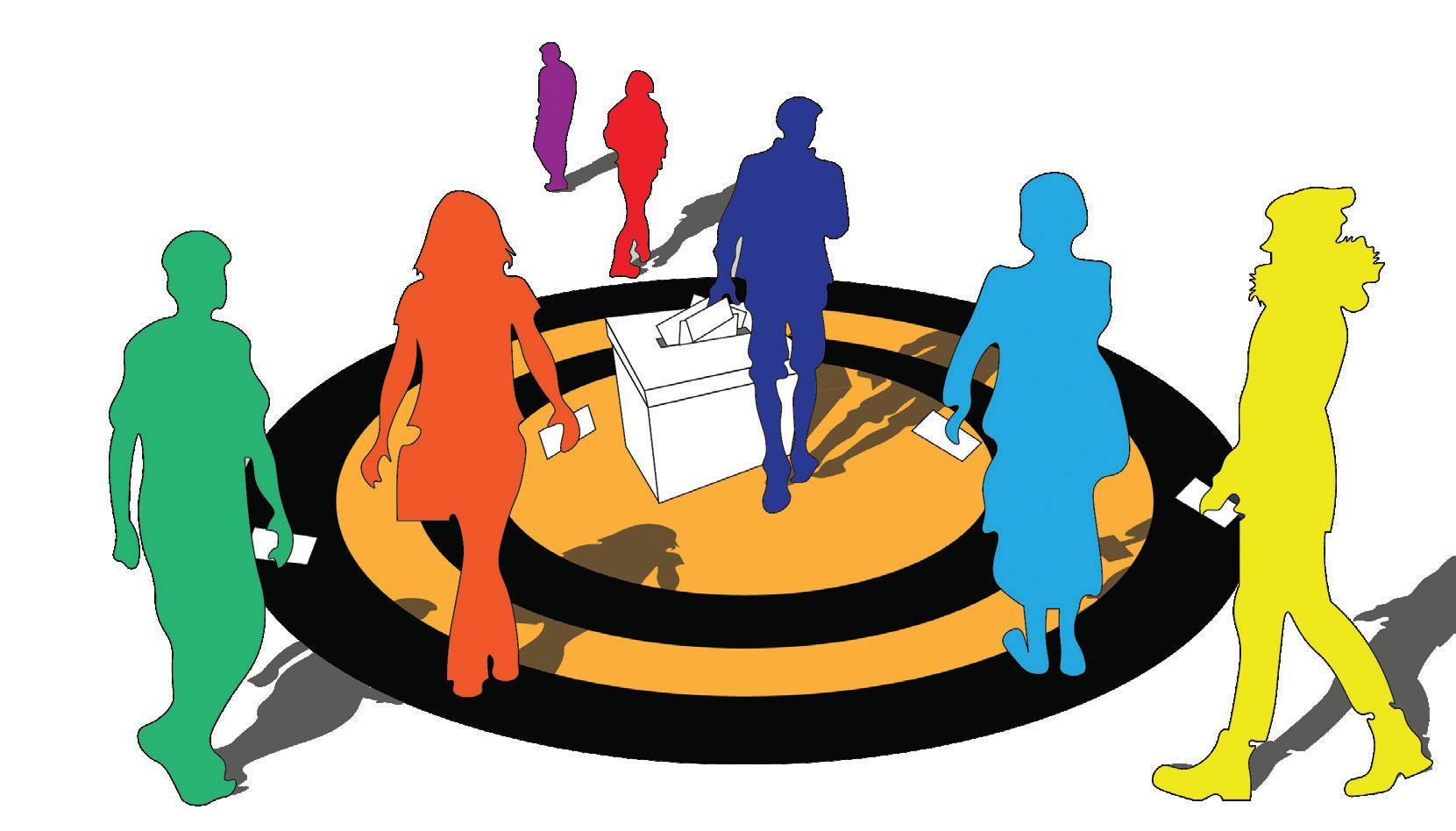
Syed Hasan, a second-year psychology student, said he has concerns about the university’s approach to student demonstrations.
“Students need the freedom to express how they feel about certain matters, and there should be more leniency,” Hasan said.
Hasan also said VCU’s handling of protests last spring is one of the reasons for student skepticism about administrative actions.
“VCU claims to protect students, but then you’re tear-gassing them,” Hasan said. “It’s a contradiction.”
Another focus of feedback is the Student Code of Conduct, which governs student behavior and disciplinary actions. Some students believe the policy updates will reinforce campus safety, others worry they
may prevent students from safer alternatives.
Sadia Hassan, a third-year business information systems student, said she would like to see some change in the Student Code of Conduct policy,
“I see other students getting rejected from RamSafe due to how they are intoxicated, but I feel that there should always be an alternative for students to travel from point A to point B so that they feel safe.” Hassan said.
Josh Skillman, director for communications and marketing for the division of student affairs, highlighted VCU’s commitment to transparency and dialogue.
“This feedback opportunity is not just lip service,” Skillman said. “It’s something that VCU really values
and has integrated into the policy development process.”
In its ongoing commitment to transparency, VCU has consistently published its “Policy Quarterly” newsletter since 2022, providing the university community with regular updates on policy developments.
This initiative ensures that students, faculty and staff are well-informed about new and revised policies, fostering an environment of openness and inclusivity via the Policy Quarterly.
The “Policy Quarterly” highlights significant policy changes from the previous quarter, allowing the community to stay informed of institutional decisions that may impact them.
Stat of the week

DREW THOMPSON Staff Writer
MARCUS LEARY
Contributing Writer
The VCU Rams handed the University of Massachusetts an 80-51 loss in their final visit to the Siegel Center as a member of the Atlantic 10 conference. The Rams climb to 21-5 overall and remain undefeated at home.
UMass is leaving the Atlantic 10 for the Mid-American Conference at the beginning of the 2025-2026 school year. The Minutemen are 11-16 overall so far on their farewell tour, 6-8 in conference play, and sit at 11th overall in the Atlantic 10 standings, according to the Atlantic 10.
UMass head coach Frank Martin said he believes that VCU has made a commitment to building a winning culture.
“It’s one of the hard places in the country to play at,” Martin said. “Whenever I call it quits;I’m going to sit back and say, ‘Man, I got to coach in that place.’”
The Rams and Minutemen came out of the gates hot, trading consecutive successful possessions before they both came crashing down.
The opening three minutes saw VCU and UMass go without a made field goal.
VCU graduate student guard Max Shulga ignited a flame under the black and gold however, hitting three consecutive
shots from behind the arc halfway through the first, according to StatBroadcast.
VCU head coach Ryan Odom said he is never surprised when Shulga gets hot.
“We rebound for him, and we know what kind of shooter he is,” Odom said. “We want to try to get him cleaner looks game in and game out. The ball found him tonight and he knocked them home.”
Shulga’s sharpshooting helped VCU gain momentum as they would go on a four-minute, 15-0 run halfway through the first, according to StatBroadcast.
The Rams began playing their usual aggressive playstyle on both sides, piling on the scoring and only allowing UMass to make three field goals in the final five minutes of the first, according to StatBroadcast.
VCU graduate student guard Joe Bamisile excited the crowd with back-toback dunks.
“God gave me the ability to dunk, so I dunk,” Bamisile said.
The black and gold would go into halftime hot, making five of their last six shots to extend their lead to 24, according to StatBroadcast.
The Rams held a commanding lead at halftime up 46-22. VCU held UMass to zero three-pointers made in the first half, while also forcing them to shoot 29% from the field, according to StatBroadcast.
Shulga led the Rams in points with 14 and five assists. Additionally, both Shulga and third-year forward Christian Fermin
made all four of their shots in the first half, according to StatBroadcast.
The second half started slowly after both teams scored in the first minute of play.
Things took a defensive turn with both teams going on a two-minute scoring drought, which was highlighted by two blocks from VCU first-year forward Luke Bamgboye on back-to-back Minutemen possessions. Bamgboye ended the night with a career-high seven blocks, according to StatBroadcast.
UMass started to claw back into the game, cutting the VCU lead 55-34 at the 13-minute mark. The maroon and white took advantage of multiple missed shots, and successfully turned defense into offense, capitalizing off a VCU turnover.
The Rams struggled offensively for the first half of the second period. VCU graduate student forward Jack Clark’s three-pointer at the start of the half was one of the only shots to go in on VCU’s first 12 attempts.
Bamisile and Clark put the Rams back in the driver’s seat at the 10-minute mark of the second half, with three-pointers on back-to-back VCU possessions.
The teams went back and forth exchanging baskets for three minutes before VCU went on a 7-0 run coming out of the under eight-minute media timeout.
The black and gold’s defense continued to keep their foot on the gas. UMass went 2-11 on field goal attempts in the final five
minutes of play and did not have a single three-pointer connect all night, according to StatBroadcast.
UMass fourth-year forward Malek Abdelgowad hit a consolation jumper in the paint to make the final score 80-51 in favor of the Rams.
VCU men’s basketball went on to play against George Mason University at the Siegel Center on Saturday, Feb. 22.


ANDREW MCGHAN Staff Writer
Despite running on a “feel good story,” this week’s pick of the week sees Nottingham Forest falling to Manchester City.
This matchup has the English Premier League’s third-place Nottingham Forest going up against the 4th place Manchester City, according to the Premier League. Only three points separate the two teams — Forest has 47 points and Man City has 44 points on the league table this season.
Man City will beat Forest because of how good City is in the attack and the experience of being premier league winners the past couple of seasons. City has scored 52 goals this season and is ranked second behind Liverpool, according to the Premier League. Forest is ranked ninth with 41 goals.
Look for Man City forward Erling Haaland to score, as he is currently second in goals scored in the league with 19, according to the Premier League.
Man City can also capitalize defensively by setting up an offside trap for Forest forwards, who have been called offside 64 times this season.
What may prove difficult for City’s defense is Forest forward Chris Wood, who is ranked third in the league with 18 goals. However, with how many times Forest has been called offside this season, it will prove difficult for Wood to make an impact on the game.
City’s attack will prove too much for Forest’s defense and City’s defense will minimize Forest’s attack.
HAYDEN BRAUN Contributing Writer
The NFL season is a rollercoaster of excitement, drama and unforgettable moments. This year was no exception, with the Philadelphia Eagles winning Super Bowl LIX in blowout fashion. This year’s Super Bowl was the most watched in history with 127.7 million viewers according to Fox Sports.
Among the celebrations and reflections on the year, one event continues to underwhelm: the Pro Bowl.
Once a highlight of the NFL year, the Pro Bowl has become a shell of its former self, leaving fans and players questioning its purpose. So, what exactly is wrong with the Pro Bowl, and how can it be fixed?
One of the glaring issues with the Pro Bowl is its lack of a permanent home stadium. The games have bounced between many locations, from Honolulu to Phoenix and Orlando to Las Vegas, according to Pro Football & Sports Network. While Hawaii was a favorite destination for players, locals and fans alike, the 2016 departure left questions unanswered.
Ultimately the move was not due to funding issues with Aloha Stadium as many speculated, but rather the NFL’s desire to explore new locations and formats to revitalize the event, according to USA Today. I do feel that the NFL must decide whether to stick with Orlando, return to Honolulu or find a new location that balances fan accessibility and player convenience.
The NFL has increasingly prioritized player safety in recent years, and the Pro Bowl is no exception.
The league has introduced flag football and prioritized mini-games to reduce the
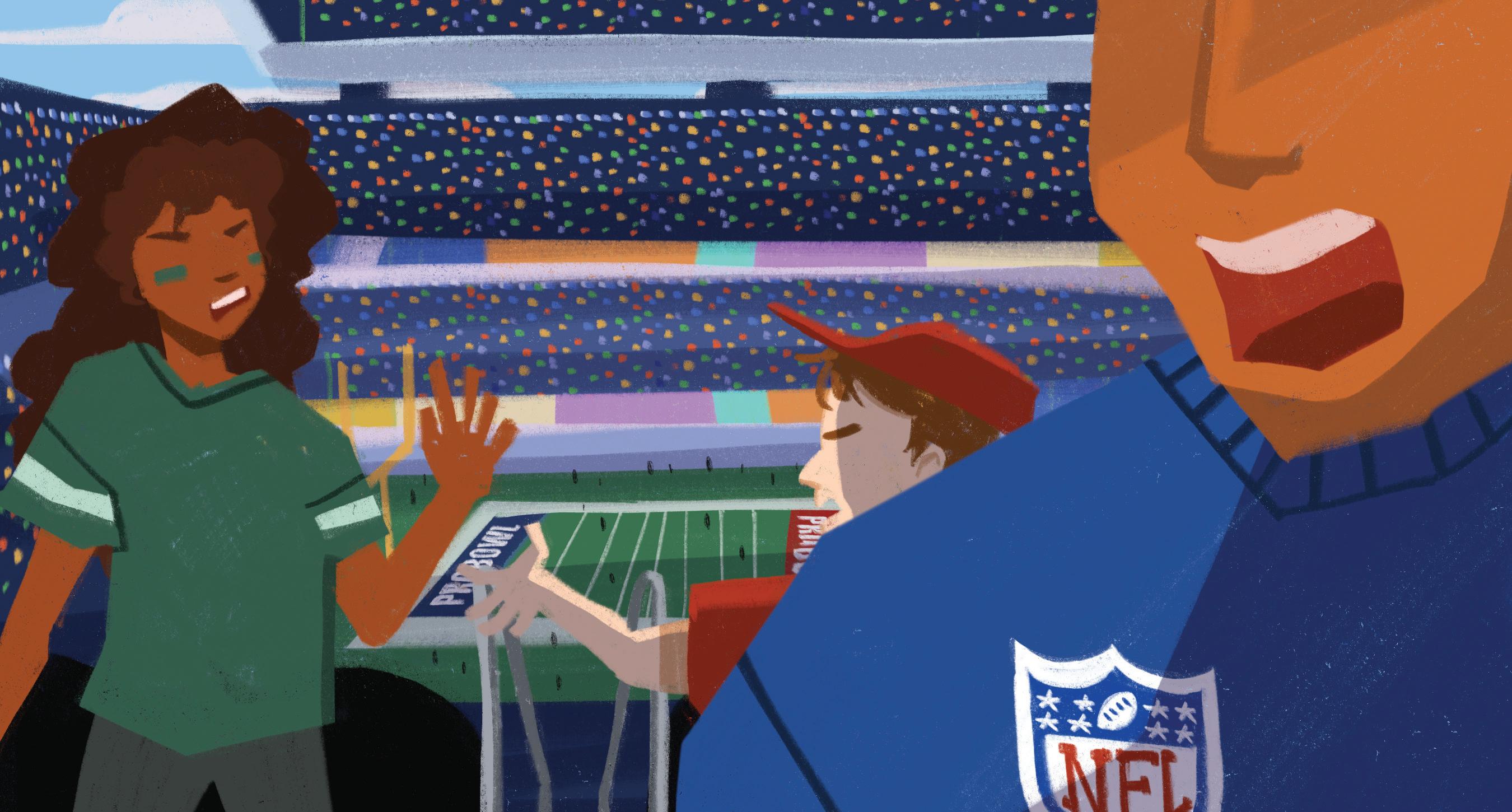
risk of injury, but this shift has come at the cost of fan enjoyment. While players may appreciate the lighter workload, audiences have grown bored with the lack of intensity.
Ratings for the Pro Bowl have declined 20% from last year’s games, according to The Sun. I think it would be beneficial for the Pro Bowl to go back to tackle football rather than flag football, but it’s extremely unlikely due to flag football being an event at the 2028 Olympics, according to The Sun.
The current NFC vs. AFC matchup has grown stale in my opinion. Personally, I think a return to fantasy-style teams could save the Pro Bowl. The games from 2013 through 2015 were so exciting to watch.
Hall of Fame football players like wide
receivers Michael Irvin and Cris Carter were picked as coaches and were able to form their teams in a fantasy-like style, similar to the sports video game Madden and its “ultimate team mode.” These games would pin teammates against one another and it was some of the most unique and entertaining football games ever.
One of the biggest challenges facing the Pro Bowl is the trend of star players opting out. Many of the league’s biggest names like Detroit Lions wide receiver Amon-Ra St. Brown and Buffalo Bills quarterback Josh Allen chose to skip the game to rest and avoid injury.
This has left the Pro Bowl feeling like a second-tier event, devoid of the star power that draws fans to the games. I understand
that football is a grueling sport and the season is long, but changes have to be made with viewership declining nearly every year.
I don’t think the athletes would be the biggest fans of required attendance but the Pro Bowl is supposed to be about the stars and some of the biggest names don’t show up. Alternatively, the league could offer incentives, such as bonuses or charity donations to encourage participation.
The Pro Bowl has the potential to be a celebration of the league’s best players, but it currently falls short of that goal. By addressing its flaws and roots the league can transform the Pro Bowl back to what it once was. Until then, it will remain a disappointment in a thrilling NFL season.
“The atmosphere was tremendous. Wonderful. We loved it. I want to thank this whole school. We needed that,” said VCU graduate student guard Phillip Russell.
Heading into this game, George Mason held the No.1 spot in the Atlantic 10 Conference with a 12-1 record, while VCU — ranked No. 2 — trailed closely behind at 11-2.
The Rams would take over the No. 1 spot in the Atlantic 10 Conference with a dominant 72-58 victory over the George Mason Patriots.


When asked about the history between VCU and George Mason, Russell acknowledged the extra motivation behind the game.
“They actually told us at the shoot around, they had done some disrespectful things a while back on the senior night. So, from there, that’s all I needed to hear,” Russell said.

George Mason took control early, jumping out to a 7-2 lead, capitalizing on the Rams offensive struggles in the first half. With the Rams only hitting only one of their first seven shots at the 15-minute mark, according to StatBroadcast.
Back-to-back three-pointers from VCU graduate student guard Max Shulga and Russell cut the deficit to 11-10.
However, the Rams continued to struggle offensively, shooting just 28% from the field at the 10-minute mark, according to StatBroadcast.
Shulga went on a solo 7-0 scoring run to give the Rams their first lead
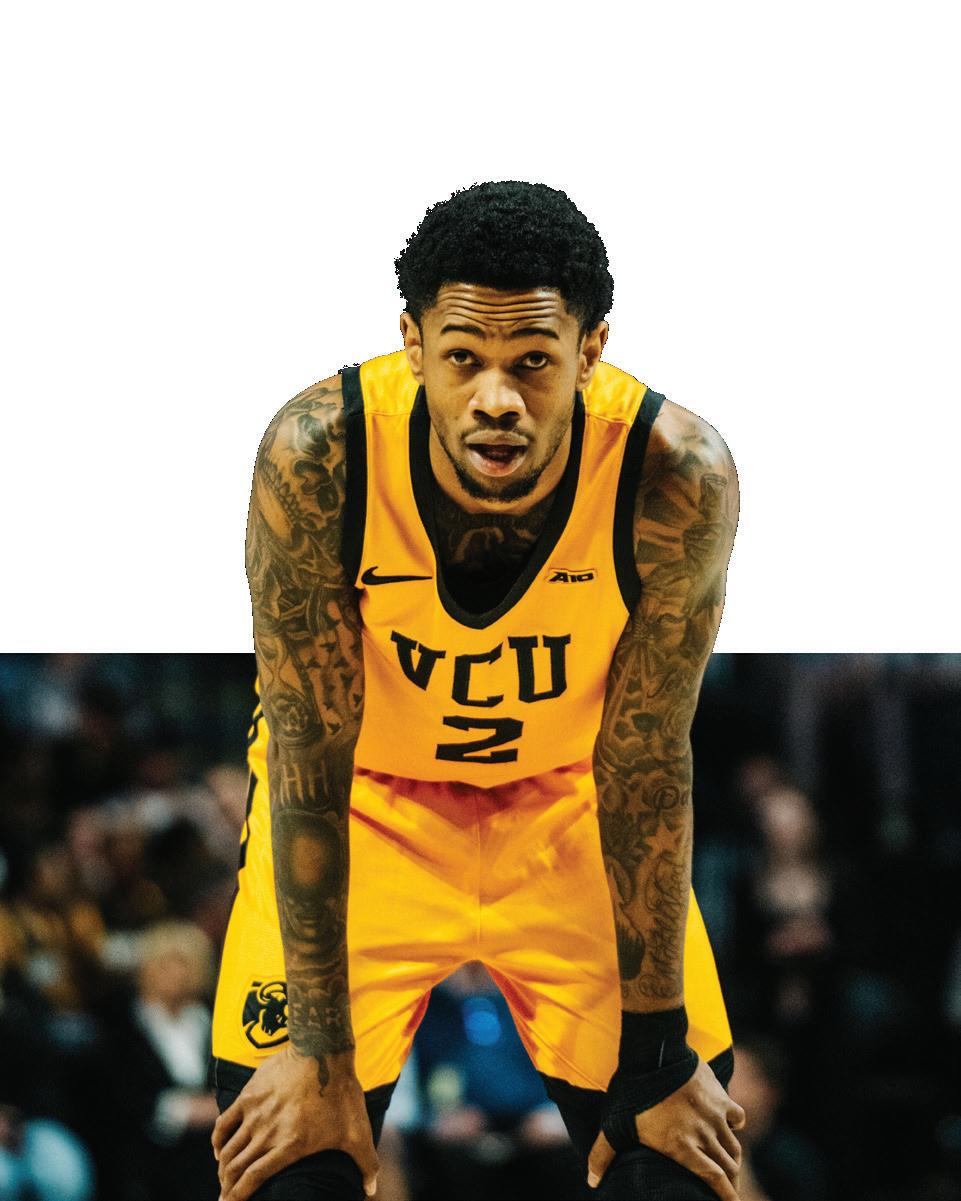


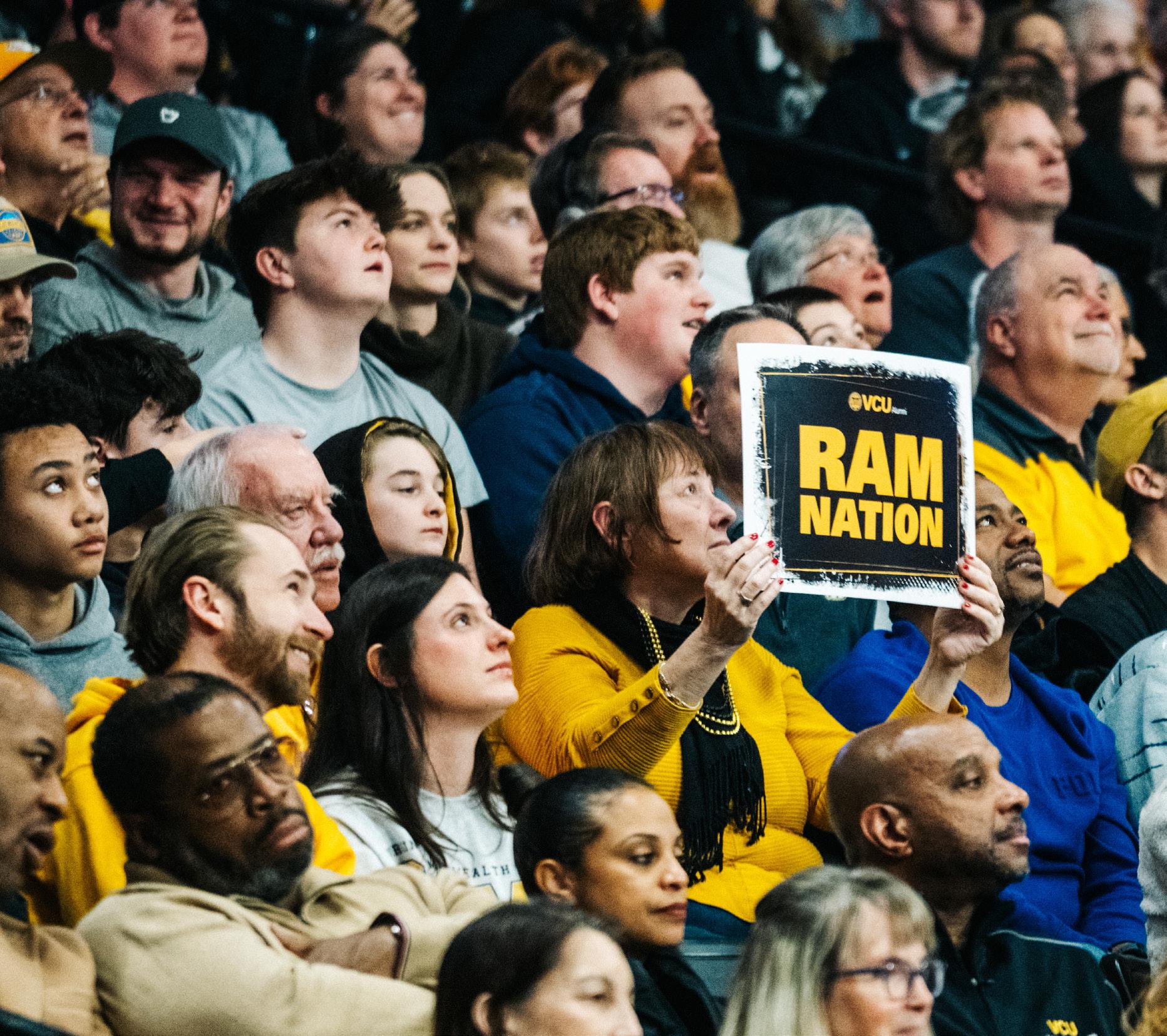

of the game 17-15 at the five-minute mark, according to StatBroadcast.
Both teams shot under 30% from the field, with neither side able to establish offensive consistency, according to StatBroadcast.
“We were taking a lot of rushed shots,” VCU head coach Ryan Odom said. “We knew we could find better shots and touch the paint more. It was just about settling down and playing our game.”
Shulga would lead all scorers with 10 points at the half, backed by two threepointers and a perfect 4-4 at the free throw line, according to StatBroadcast.
GMU fourth-year forward Jalen Haynes would lead GMU in scoring in the first half with eight total points along with four rebounds.
VCU opened the half with an 11-5 run, regaining the lead 35-29.
The Rams shot 80% from the field during the stretch, forcing George Mason into early turnovers and foul trouble.
“We knew that if we put pressure on them for 40 minutes straight, things like that happen,” Shulga said. “We just had to come out and execute, and it happened.”
VCU’s defense stepped up, forcing two GMU turnovers and a key block from first-year forward Luke Bamgboye, which would lead to a transition two-point jump shot at the 15-minute mark.
With homecoming, rivalry and the lead fueling them, the Rams rode that energy to a 13-point advantage
at the 12-minute mark, punctuated by highlight-reel dunks from VCU graduate student guard Zeb Jackson and graduate student forward Jack Clark.
Clark scored 10 of his 12 points in the second half, shooting 75% from the field and 66% from three. In addition to his scoring, he dominated the boards with six rebounds and added two steals, according to StatBroadcast.
“We started making the extra pass, moving the ball, and getting better shots,” Clark said. “That’s when we’re at our best.”
Shulga continued his offensive dominance from the first half, adding 12 points in the second to finish with 22 points, five rebounds and two steals on 55% shooting.
“Max was a monster all game,” Odom said. “You know, he just did what Max does and what we need him to do.”
VCU would outscore GMU 4730 in the second half, shooting 51% from the field. The Rams would also improve from behind the three-point line, shooting 41% from behind the arc in the second half, according to StatBroadcast.
The Rams keep their undefeated home-streak alive, improving to 14-0 at the Siegel Center the season. All wins during this streak have been double digits, with an average margin of victory of 24.5 points, according to VCU Athletics.


VCU will be back in the Siegel Center against the Davidson College Wildcats on Friday, Feb. 28 at 7 p.m.






FEBRUARY 18
BASEBALL AT LONGWOOD LOST 6-3
LACROSSE AT LONGWOOD WON 15-3
FEBRUARY 19
WOMEN’S BASKETBALL AT ST. BONAVENTURE WON 81-37
MEN’S BASKETBALL VS UMASS WON 80-51
FEBRUARY 21
MEN’S TENNIS AT PENNSYLVANIA LOST 7-0
BASEBALL AT CLEMSON LOST 6-2
FEBRUARY 22
LACROSSE AT ELON LOST 17-6
MEN’S BASKETBALL VS GEORGE MASON WON 70-54
BASEBALL AT CLEMSON LOST 4-3
FEBRUARY 23
WOMEN’S TENNIS VS EAST TENNESSEE STATE LOST 4-3
MEN’S TENNIS AT DREXEL LOST 4-3
BASEBALL VS NORTH CAROLINA A&T WON 6-3
BASEBALL VS NORTH CAROLINA A&T LOST 68-55
The first jazz records, “Dixie Jass Band One-Step” and “Livery Stable Blues,” were recorded by Original Dixieland Jazz Band in 1917.
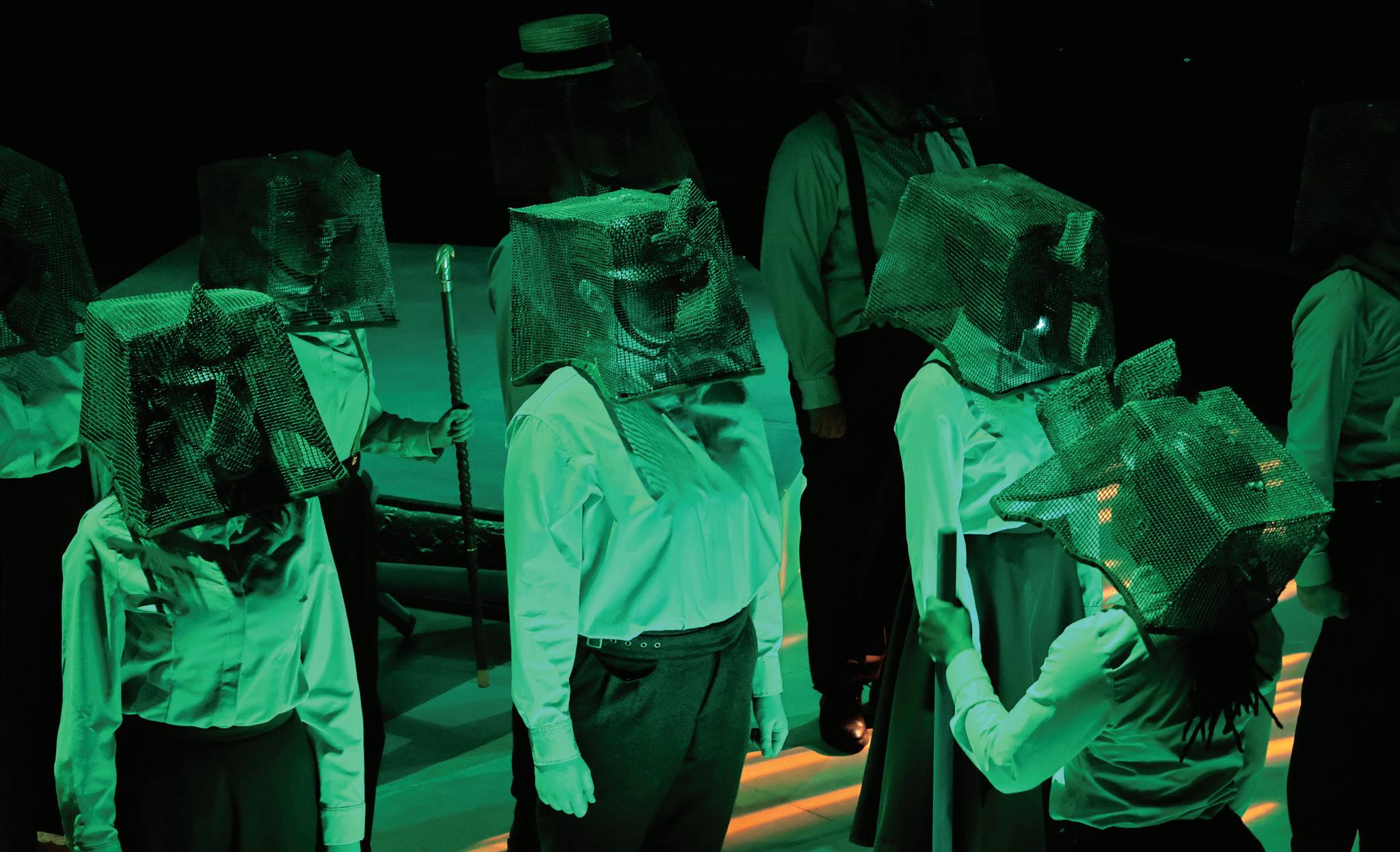
ANDREW KERLEY
Contributing Writer
VCUarts Theatre will premiere their latest Mainstage play “Rhinoceros” at the Singleton Center on Thursday, Feb. 27. The absurdist production is about a French town where the people are slowly turning into rhinoceroses, a metaphor for fascists, according to the lead Eli Wilcox.
Wilcox, a fourth-year theatre student, plays the down-on-his-luck, alcoholic Berenger, a person who “has given up on fitting in, doing his job, falling in love or being a model-anything,” he said.
Berenger slowly becomes the last person standing as the town is overrun by rhinos, according to the play’s website. “Rhinoceros” revels in its absurdity while simultaneously reflecting the deep divisions that permeate contemporary society.
“The biggest theme is the ways in which people are so easily led to a path of just hate and murder and being evil,” Wilcox said.
Jose Tenjo, a fourth-year theatre performance student, plays Botard, a contrarian who doesn’t trust journalists, says the rhinos are not real and moves the goalpost when people prove him wrong.
Tenjo said he is basing his performance off of the right-wing radio host and conspiracy theorist
Alex Jones. In the play, he tells the townspeople they cannot trust anyone but himself while basking in the attention.
“There’s actually a point in the show where he tells people, ‘Never become a rhino, rhinos are evil,’ and then literally 24 hours later he becomes a rhino,” Tenjo said.
Tenjo is one of roughly 150 people who have spent the semester preparing for the production, according to the production stage manager Jesslyn Bowers.
Erin Allen, a fourth-year costume design student, said she has been clocking in around 40 hours a week making late 1930s garments and rhino helmets. Allen’s work for the play is littered with symbology, thematic color choices and details as small as pocket squares shaped like rhinoceroses.
“The beginning of it is more kind of kitschy, storybook, almost cartoonish,” Allen said. “As it moves forward in the story it gets a bit darker, structured and uniformed. In the end, I was more inspired by brutalist architecture.”
The play is being directed by Jesse Njus, an assistant professor teaching theatre history. She said the department chose to put on the play back in 2023, knowing the political events that might transpire in 2025.
Romanian-French playwright Eugène Ionesco wrote “Rhinoceros” in the 1950s just after the rise of fascism in Europe that
culminated in World War II and during the rise of communism, according to Njus.
Njus said the play is an exemplar of the absurdist genre, a style of theatre that explores the chaos of life and deconstructs it.
“I’ve been teaching theatre history long enough that I do have a ‘before and after Jan. 6, 2021,’ because that was a shift,” Njus said.
“There’s a line that Botard says. He says, ‘No rhinoceros have ever been seen in this country.’
And that, for a long time, was a feeling in the U.S., that we were immune to a lot of this stuff. But, in fact, rhinoceroses can be seen in this country.”
The play is both a warning and a reminder, according to Njus. She said she hopes seeing the story in its absurdist setting will make people think a bit more about “why this happens,” and recognize the ridiculousness of it all.
“There are people who don’t turn into rhinoceroses,” Njus said. “It’s actually a question Berenger asks at the end of the play, ‘Can people turn back?’”
“Rhinoceros” will premiere on Thursday, Feb. 27 at 7:30 p.m. and will have four more showtimes throughout the weekend. Tickets are available on the VCUarts website and cost $20 each. Discounts are available for VCU students.
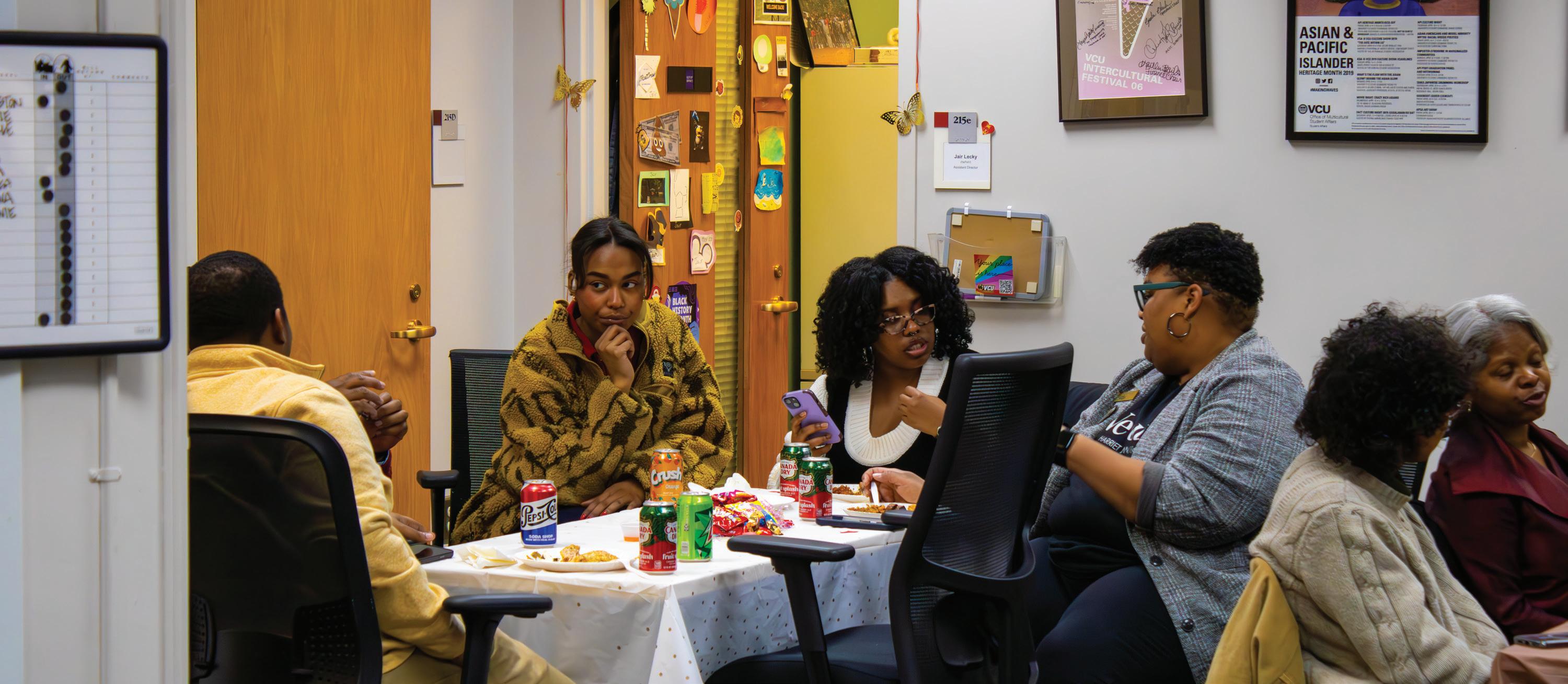
JACIÁN PERE
Contributing Writer
Students of all backgrounds gathered at Virginia Commonwealth University to celebrate Black History Month with a feast featuring a variety of African and African American dishes at the Black ‘n’ Black Mixer, held Feb. 18.
The Office of Multicultural Student Affairs in collaboration with the Black Education Association and the Division of Inclusive Influence, provided students a space to connect while enjoying food that highlights Black culture.
RaJade M. Berry-James, Ph.D., senior associate dean for faculty and academic affairs at the L. Douglas Wilder School of Government, said that community-building events like this are important.
“I think that it’s one of the ways that we break down barriers and silos — sometimes we’re so busy and committed to the work we do in our colleges and schools that we don’t
get a chance to just be in community. And I think that’s what this event is all about. Food is culture,” Berry-James said.
With 38 years of experience in higher education, Berry-James highlights the shift in how people connect within multicultural affairs. She said that in the 1980s, connection meant gathering around a table and recognizing that everyone deserved a place, with a shared responsibility to foster belonging. Today, she observes that social media has broadened the scope of connection, extending it beyond physical spaces to a global scale.
OMSA was founded in 1988 and created as a result of Black VCU students’ needs for support and resources, according to their website. In 1996, they shifted to include Latino students, further serving more underrepresented minority groups. In 2006, they expanded again, to include LGBTQ+ students. Today, they regularly host workshops and presentations with a focus on diversity, inclusion and community.
Joshua Lockhart, associate director of
OMSA, said the office hosts this gathering annually and regularly holds similar events to recognize cultural heritage months throughout the year.
Jair Lecky, a three-time VCU alumnus and program director for the Men of Color Initiative, said the diversity of Black culture was represented through food at the event.
“For some people, eating food that reminds them of home is really important,” Lecky said. “With this event, we wanted to highlight that Black people exist all around the world — and you can see that in the food we serve. It’s not just American food; we also feature West African dishes.”
The MOC Initiative offers comprehensive, inclusive programs aimed at supporting the success of underrepresented and minority male students, according to their website. By providing mentorship, building community connections and collaborating with key stakeholders, the initiative creates opportunities to enhance belonging, academic performance, professional growth and social networks for
first and second-year men of color.
Among those in attendance was Jasmine Turner, third-year health sciences student and VCU Homecoming court contender, who said events like the Black ‘n’ Black Mixer are significant, particularly in today’s political climate.
“I just feel like, especially with the times we’re in — with politics and everything — just being together and building community is the most important part,” Turner said. “Right now, all we have is each other, and we have to lean on each other. Black History Month is a time where we can do that the most because it is our month.”
Students interested in attending future OMSA events can visit omsa.vcu.edu for a full calendar of events. They can also follow @vcuomsa on Instagram or check their Linktree for updates and links to RAMS Connect pages for upcoming events.

“I learned, when I look in the mirror and tell my story, that I should be myself and not peep whatever everybody is doing.”

KYLER GILLIAM Staff Writer
As the Philadelphia Eagles were defeating the Kansas City Chiefs in the first half of Super Bowl LIX, I sat at a Super Bowl party where the full focus shifted to the halftime show that was set to come on in 10 minutes. Kendrick Lamar, the Grammy and Pulitzer prize-winning artist, was set to perform the first primarily rap Super Bowl Halftime performance. Everyone at the party was discussing what song he should start with: “Alright,” “N95,” “m.A.A.d city” and “Backseat Freestyle” were all songs that people at the party said he should do first.
The host shut the lights off while everybody huddled around the television to see what Lamar was about to display at the largest sporting event in America.
The performance opened with Samuel L. Jackson dressed as Uncle Sam, welcoming the viewer to the “Great American Game.”
It then cut to Kendrick squatting on the Black GNX Cruiser that was on the cover of his latest album release, “GNX,” in November 2024, rapping an extended version of a snippet that was released 30 minutes before the album was released.
After the snippet, Lamar said one distant statement that embodied his performance: “The revolution is about to be televised. You picked the right time, but the wrong guy.”
In that moment, everyone at the party — including myself — did a collective “Ooooh,” signaling that we were in for a show, and Lamar delivered on that assumption.
Lamar did an excellent job critiquing the policing of Black art and how it is not seen as legitimate or appropriate. The inclusion of the Uncle Sam character played by Jackson allowed Lamar to control the narrative.
Uncle Sam described Kendrick’s first part of his performance as, “Too loud, too ghetto.” This shows how middle-America was probably describing the performance at the time. Then Kendrick played two of his biggest commercial hits, “HUMBLE” and “DNA.”
Kendrick used his next few songs to take back his narrative, doing the songs he wanted to perform and making the Uncle Sam character mad again. Throughout this struggle, Kendrick teased “Not Like Us,” the biggest song of 2024, that won five Grammys two weeks prior.
Drake, who the song is primarily about, is currently suing Universal Music Group for defamation over the song, according to CNN. There were concerns that Kendrick would not even perform the song due to the lawsuit, but Lamar played it anyway. This combined as both a victory lap for Lamar over Drake and helped his narrative on the policing of Black art.
In the end, everybody at the party was entertained and while the Eagles continued to defeat the Chiefs, the party talked about the performance.
But after the show and three full rewatches, I’ve come to the conclusion that the revolution cannot be televised.
The reference to Gil Scott-Heron’s, “The Revolution Will Not Be Televised,” in the moment is good — but after deeper analysis, the message falls flat.
The National Football League is the standard of American exceptionalism in the sports world, a game primarily played in the United States, and it is the most watched sport in American households.
Billionaire owners, protection of domestic abusers, Black, brown and poor bodies being used for our entertainment, military propaganda and the dismissal of racial and socioeconomic problems that were brought up by players such as former San Francisco 49ers quarterback Colin Kaepernick are all issues that the NFL faces.
Lamar’s performance cannot be a revolutionary piece on a stage owned by the NFL. Apple cannot sponsor the revolution. Advertisements for Mountain Dew and Uber Eats cannot air after the revolution.
The NFL had fully approved Lamar’s performance, thus co-opting the message. The oppressor cannot co-opt your message if it is meant to revolutionize the people. That means the threat of revolution is not there.
What I took away from Lamar’s performance is a well-thought critique of Black artists playing the “game” and either appealing to a white audience or staying authentic within themselves, not a revolution for the people. However, we can still use the artistry of Lamar to highlight the growing issues in today’s America.
Lamar’s performance cannot be a revolutionary piece on a stage owned by the NFL.
Apple cannot sponsor the revolution.
Advertisements for Mountain Dew and Uber Eats cannot air after the revolution.
JALYN THOMAS
Contributing Writer
It took me a year and a semester to figure out what I wanted to do with my future and it’s taken President Donald Trump two months in office to convince me I should have chosen something safer.
I love free speech as much as I’m sure whoever is reading this also loves it. This whole country is built off of free speech. It’s why we’re able to say what we want without legal repercussions, though of course, the internet gives a better punishment. Free speech is ironically the backbone of our country and is something that is the most targeted.
Since the day President Trump was sworn into office, it has felt as though an executive order was being signed each day. On those days I wonder if I chose the right path. Maybe I should’ve gone a more scientific route or maybe just decided to do
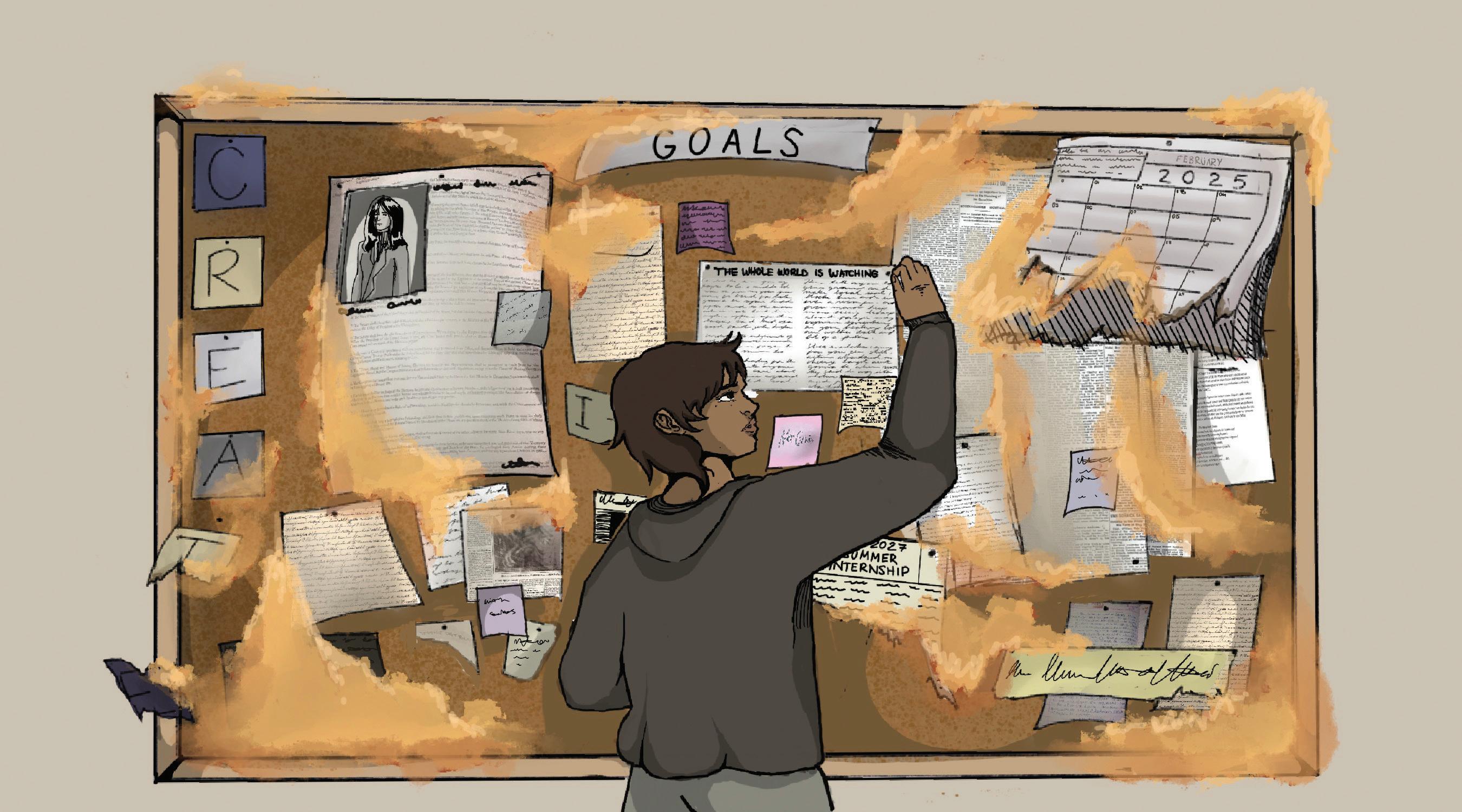
business like before — when I just chose a major to make others happy. Those would have been terrible for my mental health and they would’ve also been a cop-out.
Kendrick Lamar was the halftime performer for Super Bowl LIX. After the performance, you could go online and see how much hate he got for a powerful performance not many would have been able to pull off. A lot of the hate was coming from conservatives or politicians who understood the message and didn’t like how it was calling them out — or people
who love Drake.
As I was scrolling through X, I was wondering: What am I supposed to do?
These people claimed to not like Lamar or know who he was, even though he had won five Grammys one week prior.
What does that mean for someone like me — a third-year student studying media production and public relations?
Should I just say what would make the majority happy? I could always start a farm and never use my skill of telling a story. It’s a scary feeling when you spend all that time
advertisement
trying to figure out your future and in just four years it could all be for nothing. I graduate next year. I will go out into the workforce and try to find my way in a field I am passionate about. With that, I will continue talking about things that need to be brought to attention. I will think about the topics that everyone wants brought up but nobody is in a position to talk about. I will bring myself to the position to talk about those topics, and hopefully prevent someone else from feeling like all they did to get here was for nothing.

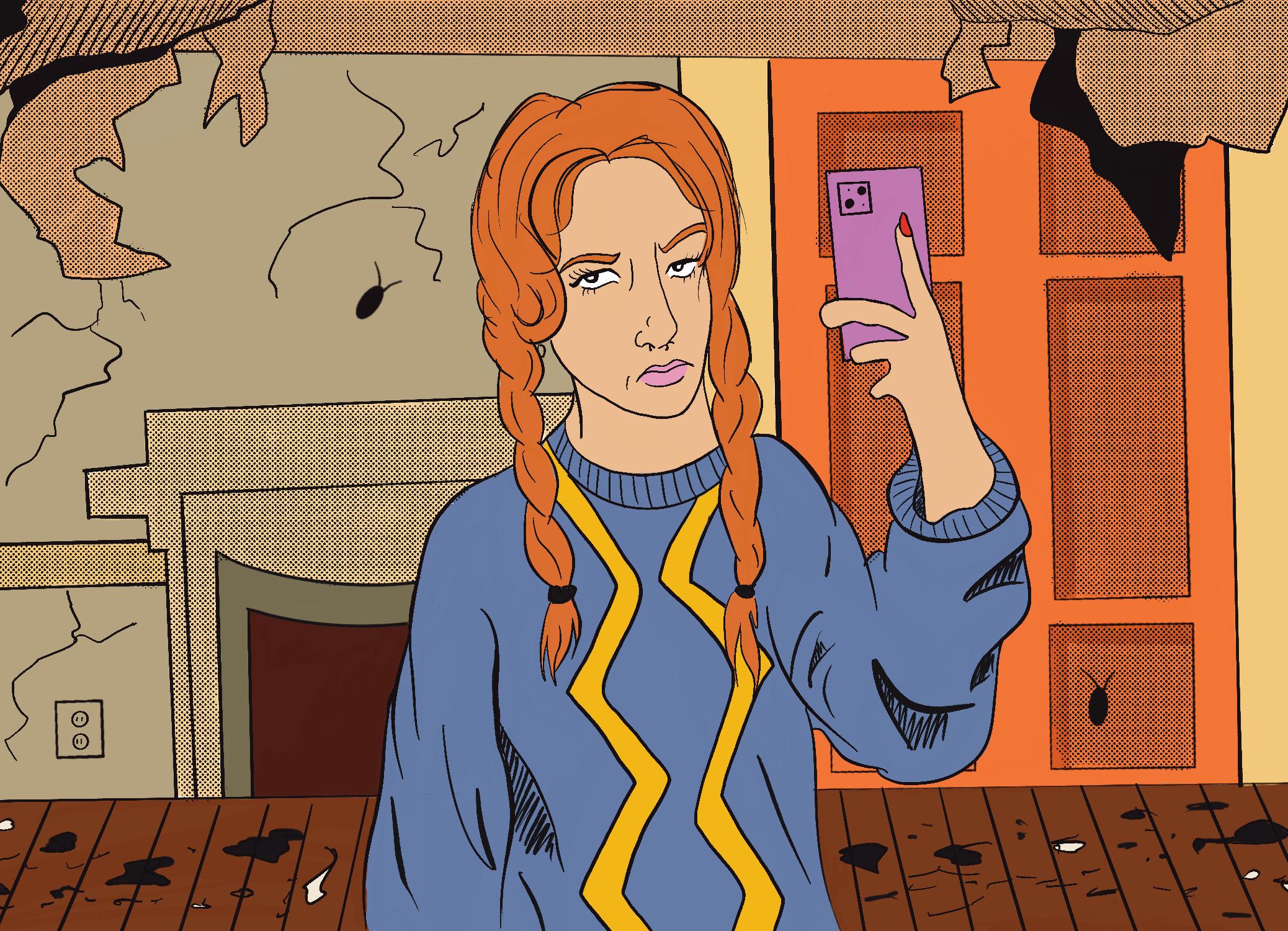
NATALIE MCEWAN
Opinions and Humor Editor
VCU’s housing crisis has forced many students off campus, all while rents in the neighborhoods around VCU rise and landlords rent buildings in hazardous conditions. More than half of Richmond renters pay more than 30% of their income on rent and utilities. I am just one of many students who live under property managers who refuse to do basic maintenance — a story all too common in Richmond.
If VCU wants to grow as a university in size, funding and prestige, they need to address the welfare of their students — and their students’ living conditions. They don’t just need to build more dormitories, they need to work with Richmond to hold landlords and property managers accountable.
I moved into an off-campus apartment in the Fan in May 2024. I — like many other VCU students — was charmed by the chance to live in an old, historic building. I knew maintenance issues were bound to happen, but I figured as long as I knew my rights in the Virginia Landlord and Tenant Act, nothing could really go wrong. Looking back, I want to laugh at my
former self. The wooden rails on the third-floor balcony are so rotten they crumble under the slightest pressure, the fire escape is filled with loose, wobbly steps and the window in my bathroom is caulked half-open.
I have reported all of these to my property management company, Henry Briggs Realty. Each time, they claimed someone would come check on it. Some maintenance issues only got fixed after I sent emails citing legal code. Many maintenance issues took months and multiple emails to get fixed — if at all.
It was not until the ceiling caved in the lobby before winter break, until I went without heat for over a month during the coldest weeks in Richmond, that I realized just how unsafe my apartment had become. I learned a different kind of misery when I was under three blankets in January, shivering day and night, as I called them daily to fix my heat.
On the outside it looks beautiful — but look too closely at the layers of paint and you’ll notice years of decay.
My story is far from uncommon in Richmond. Ask a VCU student living offcampus and chances are they have their own landlord horror story. A quick Google
reviews search into Pollard and Bagby, Dodson/Evernest, KRS Holdings and many other property management companies will yield horror stories you can hardly imagine. These companies are only one part of the problem, the other being the owners of the buildings.
Many of the properties managed by Richmond’s notorious slumlords are actually owned by individual investors, some not local to the city. When I searched city records, I learned my property was actually owned by a millionaire based in the Washington D.C. area, someone who likely has little understanding towards any of the hazards this apartment puts me in.
For VCU to help the housing crisis, they need to work with Richmond to hold landlords and property managers accountable. But in order to do that properly, VCU also needs to acknowledge its role as the biggest landlord in Richmond.
At the end of the day, a university is a business first. Peel back into many of the problems facing colleges today — from climbing tuition rates to grade inflation — and profit is the goal. Acquiring property helps VCU invest money which helps them develop the university further. However — many of the acquired properties sit empty.
Many Richmonders and VCU students see VCU less as a benevolent institution and more as a money-hungry business treating Richmond like their personal Monopoly board.
In many ways, my time at VCU has been wonderful. That experience is due to the professors I learned from, the classes I took, the work I created and the people I met. But my time at VCU has also taught me that I cannot trust this institution to act with my best interests at heart.
So, as students, how can we look out for ourselves? We need a place to live. I don’t have many answers right now, but my biggest piece of advice is to get loud. Get annoying. Read reviews of your landlords online before signing a lease. Know the Virginia Landlord and Tenant Act like the back of your hand. Keep a paper trail of maintenance neglect. Document everything. Get the court involved if you need to. Put pressure on our local politicians.
It’s time we stop letting Richmond landlords get away with laziness while we shell out money. It’s time VCU took action. Because mold, rotting wood, leaks and splintered floors have risks to our wellbeing — and even our lives.
Joke of the week
“I didn’t go to college, but if I did, I would have taken all my tests at a restaurant, because the customer is always right.”
— mitch hedberg

DYLAN HOSTETTER Executive Editor
The weather and I have always had an antagonistic relationship. Throughout my entire life, I’ve had birthday parties cancelled for rain, lost baseball caps in the wind and even had a cat once get struck by lightning. It was probably because my brother was feeding him all those pennies, but it was tragic nonetheless.
My less-than-positive relationship with weather sadly followed me here to VCU — though I never expected it to be this extreme. I knew trouble was brewing when I got the VCU Alert about a tornado warning. I went downstairs to find my roommate laying under a “Cars” blanket in the bathtub.
“I guess you saw the VCU Alert,” I said. “I don’t think this will protect you from a tornado.”
“There’s a tornado?”
Whether or not there was, I refused to shelter in place — Mother Nature had hassled me for long enough. It was time I took a stand. As I ran outside, I could see clouds beginning to swirl in the sky. They looked like cotton candy, only evil. Evil cotton candy — how could such a horrible image be conjured in my brain?
The weather seemed to be aware of my resistance, as once the funnel of the tornado began to reach down from the sky, the storm moved over VCU Agriculture’s newly installed ram sanctuary and petting zoo. What seemed like a good idea to boost school spirit and save some animals was about to turn into a nightmare.
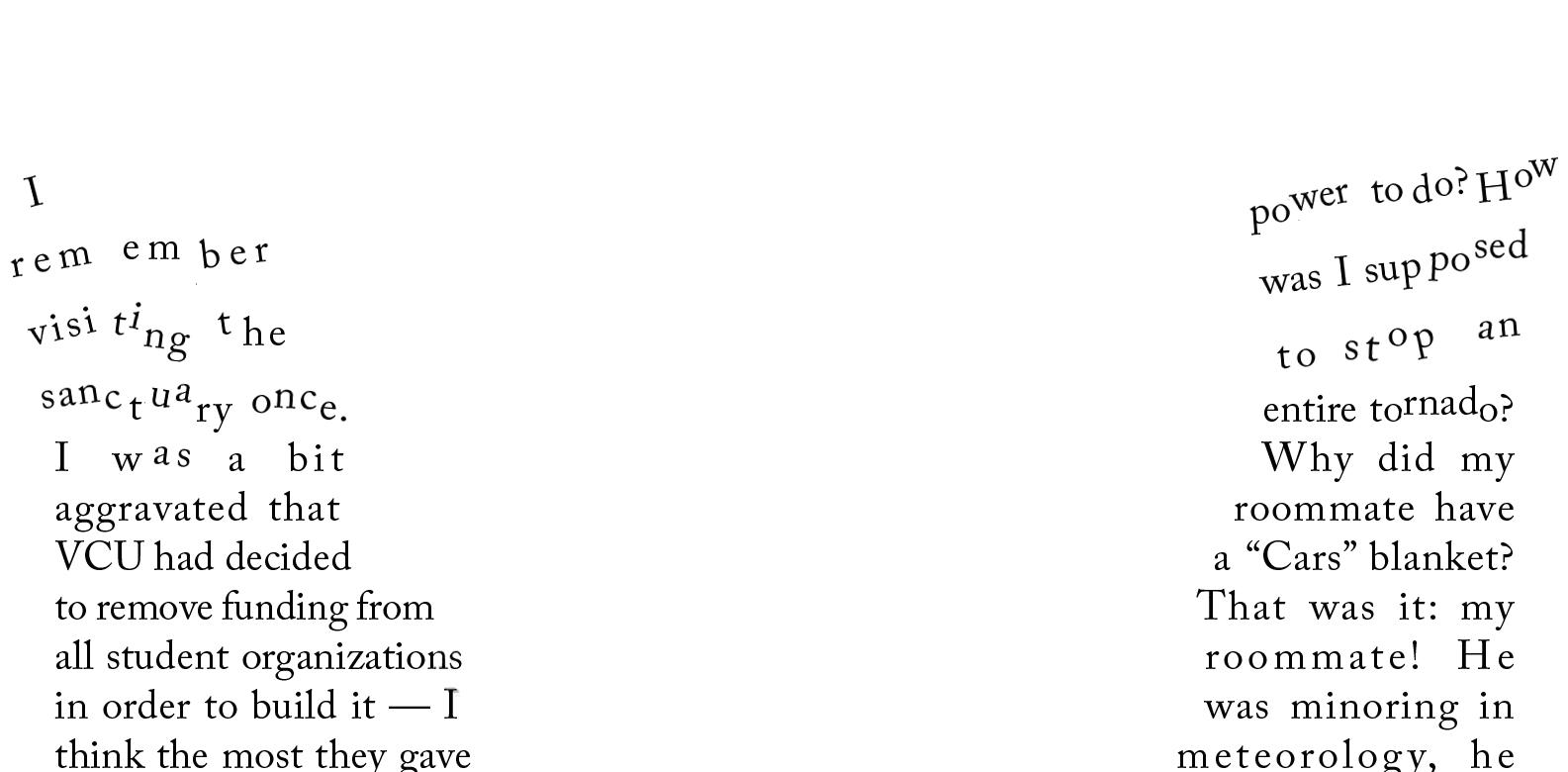
think the most they gave the English club was a box of Kit Kats for the entire semester — but those rams were so darn cute and soft.
The tornado wasted no time in destroying the entire facility. Before I had time to mourn the loss of all those rams, I noticed something: The tornado had sucked them all up. They were part of it now, fused with the whirling winds. It was a ram-nado.
I had heard of something like this before; I believe it was a tornado full of whales? Dolphins? I couldn’t remember. Nonetheless, it was a bad situation. A tornado of flying fish is one thing, this was a bunch of agitated, horned rams heading directly towards campus. It could have caused more devastation than the time the Commons was unable to sell fountain drinks.
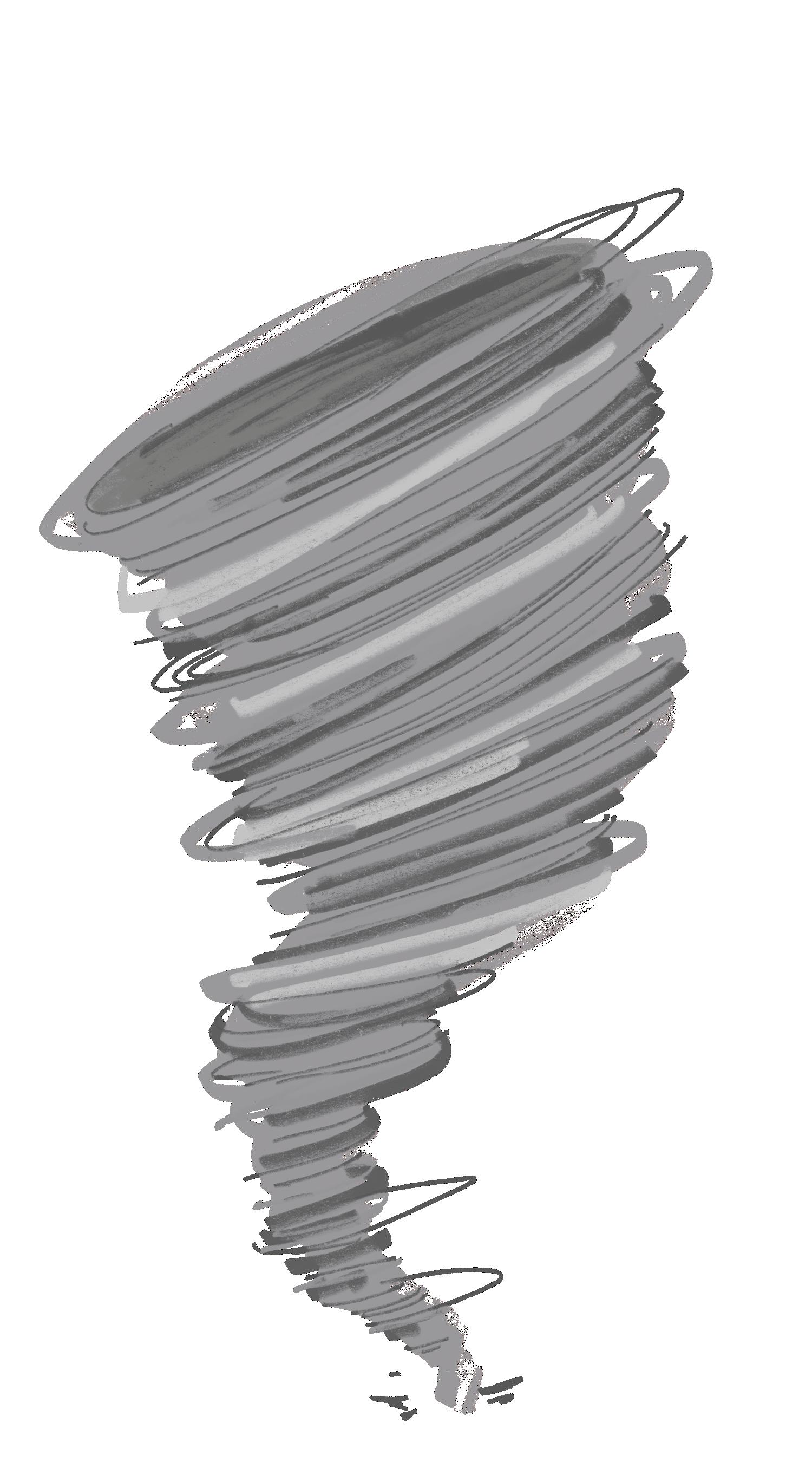
meteorology, he would know how to
“No, meat-ology,” he said from under the blanket. “I have no clue how
“The study of meats and cheeses, though without the cheese,” he said.
“I’m up for a job at Jersey Mikes and it’s going to look great on
I abandoned that idea and ran back outside. At that time, I could see the ram-nado touching down on campus. VCU basketball was playing George Mason in a soldout Siegel Center. The tornado ripped through the stadium’s roof with ease, sucking a sea of black-and-gold t-shirtwearing fans into its windy, hoof-filled maw.
I hadn’t seen that much destruction at the Siegel Center since the Rams last faced the Richmond Spiders.
straight for Monroe Park — it was the only safe place to sequester the ram-nado.
Along the way, the ram-nado picked up a few straggling pedestrians and students that I couldn’t alert in time. I tried to stop one guy from walking right into the ramnado, but refused my warnings.
“Miss Merrywhether didn’t believe I had pneumonia, but she’ll sure believe this,” he said, before running right into the cyclone.
There is no scientific evidence that tornados can be stopped, so all I could think to do was bunker down inside the Espresso A Go Go and wait for the ram-nado to end. I could hear the bleats of the rams and the clack of their horns into the night until I drifted off to sleep.
In the morning, all was silent. I walked out of the brick building to find a serene scene — Monroe Park littered with calm rams feeding on dewy morning grass. The Siegel Center fans were still there, shaken but calmed by petting the rams’ thick coats. The air was uncharacteristically warm for February.
I was happy everything was calm and no one got hurt. To treat my success, I walked to a nearby ice cream stand and picked up a cone. As I went to take my first bite, the wind blew the scoops right out of the cone. Mother Nature just can’t give me a win.
I knew I had to do something; after all, it was my defiance of nature that caused this insane catastrophe. But what did I have the
The ram-nado then made a b-line straight for me. I could see the poor VCU fans bouncing around, dangling themselves off of the rams’ horns. Once I realized it was following me, I got an idea and headed
Editor’s Note: The characters and events depicted in this story are fictitious. Any resemblance to real persons, living or dead, is purely coincidental.



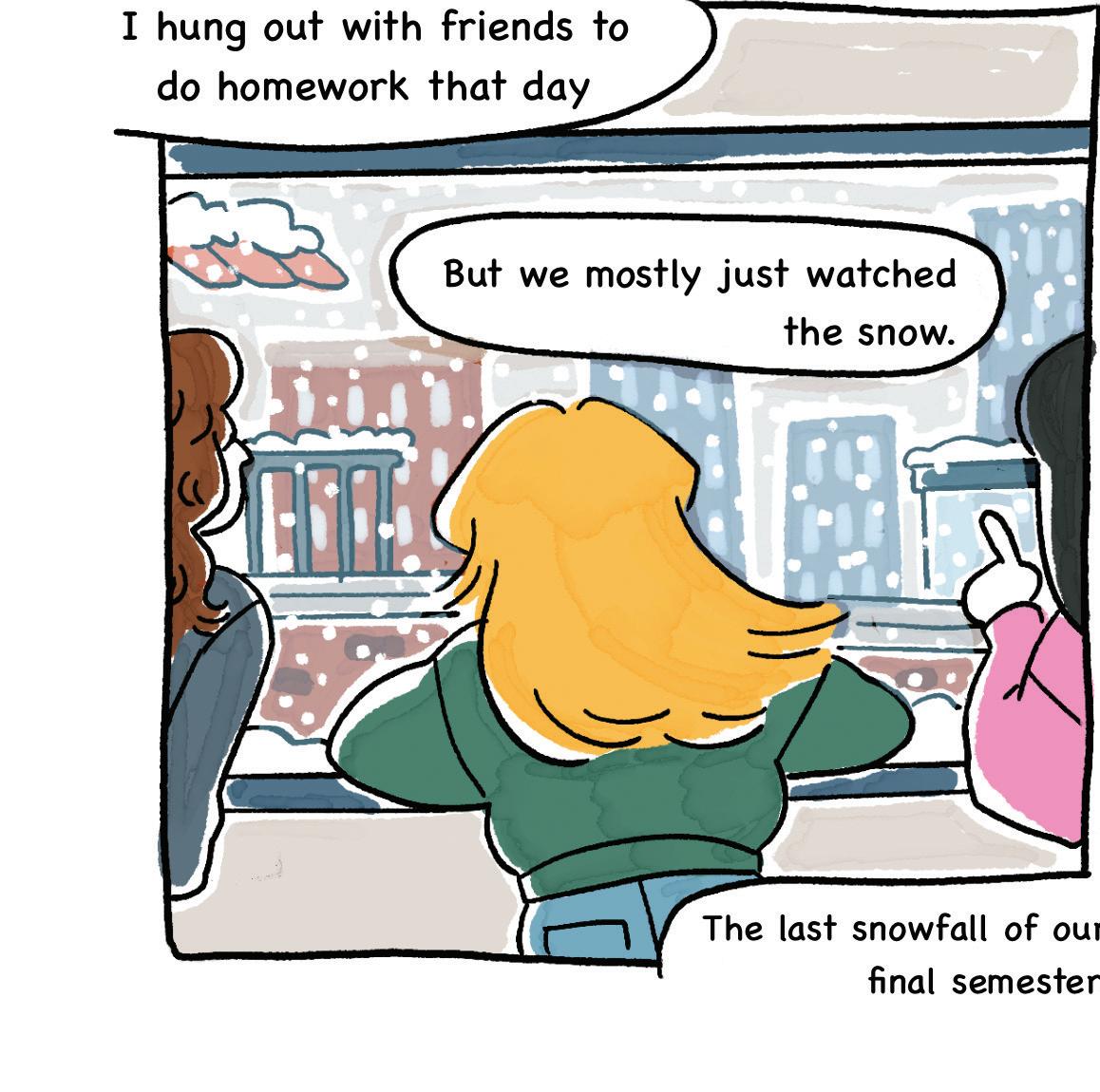

By Ryan Mathiason
By Ryan Mathiason
Edited by Patti Varol

Edited by Patti Varol
Edited by Patti Varol
